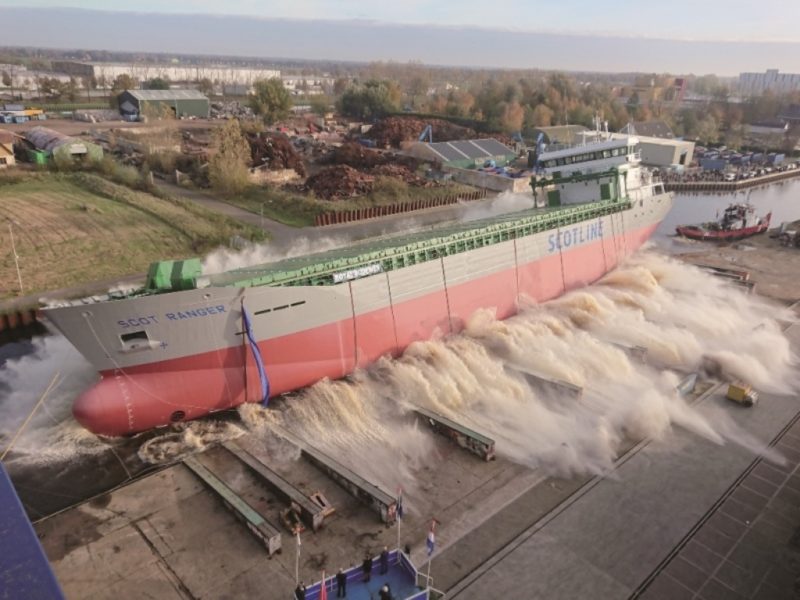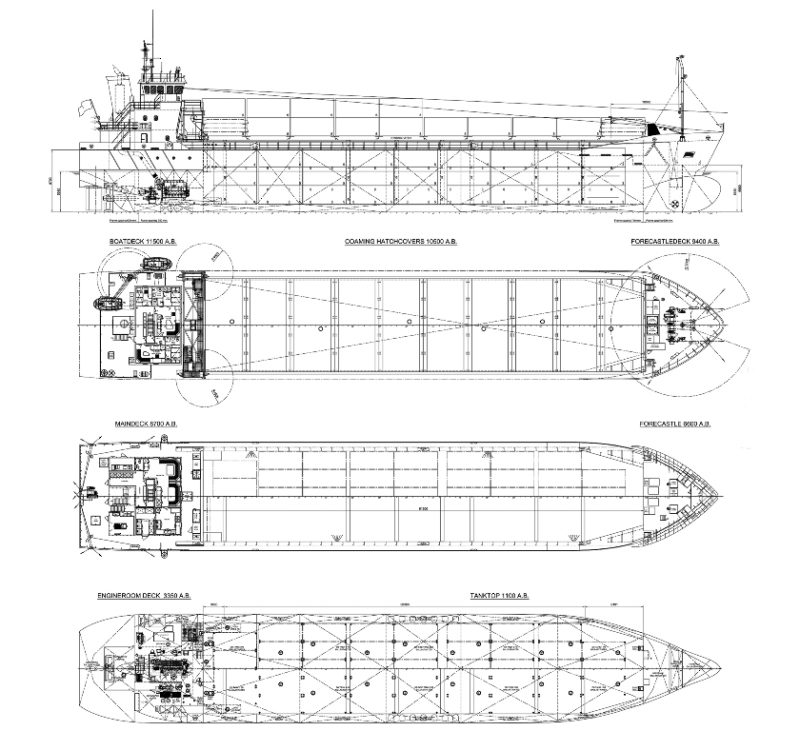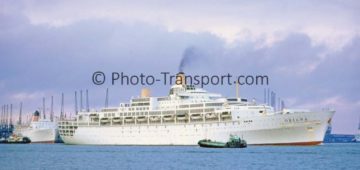 Scotline is a shipping company that has its roots planted firmly in the U.K with the present day registered offices being in Romford, Essex and an operational hub in neighbouring Kent at Rochester. The company celebrated 40 years of trading in 2019 and can trace its origins back to 1979. The first cargo was carried that same year under the Scotline trading name, a shipment of logs between Inverness and Bremen in Germany, which became a regular route, before this changed to Inverness-Varberg (Sweden). In 1981 the company chartered its first vessel and set up the Scotline liner service, transporting sawn timber from Varberg to Inverness as a joint venture with Scotlog Sales. In the present day the liner service has established trade routes between Denmark, Germany, Ireland, Norway, Sweden, the Baltic States and the U.K. The initial service employed charter vessels until 1994 when Scotline Marine Holdings Ltd., a close business partner, purchased its first vessel, the Hohebank, which was time chartered by Scotline. The original operation at Inverness was expanded to additional sites at Whitstable in Kent and Goole in Yorkshire, before moving to Gunness in Yorkshire and Rochester in Kent during 1994. The 10-acre site at Rochester, on the banks of the River Medway, is owned by Scotline Terminal (Medway) Ltd. and was much larger than the facility used at Whitstable. The site was developed to include office facilities, 2 large warehouses, secure storage for equipment and a base for an engineering team to meet the requirements of the ships and terminals. By 2010 the space at the Rochester site had been completely exhausted and more was required. A second terminal was sought and acquired in January 2011 by Scotline Terminal (Transit) Ltd., adding a further 14 acres to the storage space available to Scotline in Rochester. The company’s head office was originally based in Holborn, London, before moving to Romford where it still is today. The fleet has seen considerable investment in the past five years with the 2,571gt/2017-built Scot Navigator, a GS Eco Freighter 3700 design, being followed by the announcement on 1st February 2018 that a contact had been signed with the Royal Bodewes Group BV in Holland to build the 3,450gt/2018-built Scot Carrier in the November of that year. This vessel was followed by 3,457gt/2019-built sistership Scot Explorer. A further newbuild was ordered on 28th July 2019 in the form of the 3,457gt/2021-built Scot Ranger, also of the Bodewes Trader 4800 design. Scotline was pleased to have a Scot Ranger in the fleet again, with her previous namesake being the 2,260gt/1997-built Scot Ranger that was disposed of in 2019 after 22 years of service. She continues to work as the Rova for the Rova Shipping Company in Germany and was Scotline’s first newbuild vessel ever commissioned, as well as being the last ship built at Yorkshire Dry Dock in Hull.
Scotline is a shipping company that has its roots planted firmly in the U.K with the present day registered offices being in Romford, Essex and an operational hub in neighbouring Kent at Rochester. The company celebrated 40 years of trading in 2019 and can trace its origins back to 1979. The first cargo was carried that same year under the Scotline trading name, a shipment of logs between Inverness and Bremen in Germany, which became a regular route, before this changed to Inverness-Varberg (Sweden). In 1981 the company chartered its first vessel and set up the Scotline liner service, transporting sawn timber from Varberg to Inverness as a joint venture with Scotlog Sales. In the present day the liner service has established trade routes between Denmark, Germany, Ireland, Norway, Sweden, the Baltic States and the U.K. The initial service employed charter vessels until 1994 when Scotline Marine Holdings Ltd., a close business partner, purchased its first vessel, the Hohebank, which was time chartered by Scotline. The original operation at Inverness was expanded to additional sites at Whitstable in Kent and Goole in Yorkshire, before moving to Gunness in Yorkshire and Rochester in Kent during 1994. The 10-acre site at Rochester, on the banks of the River Medway, is owned by Scotline Terminal (Medway) Ltd. and was much larger than the facility used at Whitstable. The site was developed to include office facilities, 2 large warehouses, secure storage for equipment and a base for an engineering team to meet the requirements of the ships and terminals. By 2010 the space at the Rochester site had been completely exhausted and more was required. A second terminal was sought and acquired in January 2011 by Scotline Terminal (Transit) Ltd., adding a further 14 acres to the storage space available to Scotline in Rochester. The company’s head office was originally based in Holborn, London, before moving to Romford where it still is today. The fleet has seen considerable investment in the past five years with the 2,571gt/2017-built Scot Navigator, a GS Eco Freighter 3700 design, being followed by the announcement on 1st February 2018 that a contact had been signed with the Royal Bodewes Group BV in Holland to build the 3,450gt/2018-built Scot Carrier in the November of that year. This vessel was followed by 3,457gt/2019-built sistership Scot Explorer. A further newbuild was ordered on 28th July 2019 in the form of the 3,457gt/2021-built Scot Ranger, also of the Bodewes Trader 4800 design. Scotline was pleased to have a Scot Ranger in the fleet again, with her previous namesake being the 2,260gt/1997-built Scot Ranger that was disposed of in 2019 after 22 years of service. She continues to work as the Rova for the Rova Shipping Company in Germany and was Scotline’s first newbuild vessel ever commissioned, as well as being the last ship built at Yorkshire Dry Dock in Hull.
The new Scot Ranger is a close sister to the previous two new additions to the Scotline fleet but the ‘Ranger has ice class 1A (Finnish and Swedish Ice Class Regulations 2010), meaning that she can continue to support the company’s services from the Baltic during the tough winter months. Her two sisters are ice class 1B. The Scot Ranger, Yard No. 750, was launched at the Royal Bodewes Shipyard, Hoogezand, The Netherlands, on 6th November 2020 but, alas, due to the pandemic, the ceremony was a scaled down affair. The Godmother duties were carried out by Ria Kuiper, wife of Dik Kuiper the broker from JR Shipping, prior to the official christening and launch. After the event there was still work that was required to be done while the ship was in the water alongside at the shipyard. The Scot Ranger was then towed to sea at Delfzijl on 4th January and proceeded under her own power to Eemshaven where a week of sea trials followed. Hand over to Scotline Marine Holdings followed on 14th January 2021. The market remains firm and the liner services are very busy so there was no shortage of work for the new arrival. Her first revenue earning voyage was to load palletised cement in Aalborg, Denmark, before collecting a consignment of sawn timber from Varberg prior to continuing to Rochester on the liner service. Readers may notice that the keel laying date for the Scot Ranger is June 2014 when the ship was only ordered in 2019. This is correct as the shipyard had a stock of keels for the Trader 4800 series. This is often done to assist the speed of a newbuild and to also permit multiple builds over a period of time that follow the design requirements and characteristics at the time of keel laying.
Proven Design
The Royal Bodewes Shipyard was officially founded by Shipbuilder Geert Joosten Bodewes in 1812, using the date of his marriage, although he had been running the fledgling company before this.
The yard was flourishing by 1882 with the focus turning to steamships in 1908. The shipyard made use of the latest technical developments, and the introduction of the diesel engine led to the construction of motorised barges and coastal vessels. The diesel-powered NB 606 was launched on the 18th of May 1916. The first coastal vessels solely powered by an engine were built in 1931. The post-war years focussed on orders from both Dutch and foreign customers and, in the 1970s, an imposing construction hall was built at the shipyard. For a number of decades, the business operated its own shipping company with an average fleet of five vessels. In 1986, when the shipyard management no longer had family members to serve as successors, it was transferred to non-family members. In 1988, the company signed a contract to build two multi-purpose Ro-Ro vessels, the very first of their kind. In 1990, the shipyard introduced the Bodewes 4250 DWT ship type and built six of them. The new millennium brought a succession of new ship types designed by Bodewes that responded perfectly to the needs of the market. To meet demand the shipyard subcontracted hull builders in Ukraine, China, India and three in Poland as well as two construction companies in Romania. In 2010, Bodewes Shipyards and Universal Africa Lines (UAL) arrived at a partnership for building and operating Eco Trader 8700 seagoing vessels. Nescos Shipping B.V., the shipping company founded for this purpose, is a subsidiary of Bodewes Holding B.V. and has expanded to operate five 8,700gt vessels. In 2012, the shipyard celebrated its 200th jubilee and received the honourable title of ‘Royal’ on this occasion. Since then, the Bodewes Shipyard has been known as Royal Bodewes whilst the infrastructure of the dockyard was improved to increase efficiency. The existing red construction hall was also extended and capacity increased with the building of an identical hall next to it. The canal next to the shipyard was widened for launching purposes. In 2015, the shipyard’s order portfolio included a range of advanced vessels: the 6,015gt/2017-built LNG Flexitanker Coralius, two 4,700gt eco-coasters and two cement tankers. Constructing the hulls of these vessels was subcontracted to the company’s partners in Poland. Since the accessibility of the shipyard in Martenshoek depends on the navigable width of locks and bridges, Royal Bodewes also has a well-equipped shipyard in the neighbouring city of Papenburg in Germany. The shipyard offers a range of six types of dry cargo vessel including the Trader 2650 Sea River, Trader 3450 General and the geared Eco Trader 8700 plus tankers such as the Bodewes 6500, cement carriers and more. The Eco Trader series and the coastal tanker design feature the cross-bow hull form. Arklow Shipping is but one of the long-term clients. The popular Bodewes Trader 4800 ship design, with examples including the Scot Ranger of course, have an overall length of 89.98m, a beam of 15.20m and a maximum draught of 5.69m. The gross tonnage is 3,457, the deadweight is 4,471, the net tonnage is 2,201 and the air draught in ballast is 28.30m. By the nature of the ship type, all superstructure is located at the stern with the Tween Deck being the lowest of the four levels, and 5.95m above the ship’s baseline. Located here are six crew cabins for 7 crewmembers and officers (5 single cabins and 1 double) plus laundry facilities. One level up is the main deck, 8.70m above the baseline, and this caters for the mess room for a crew of 9, galley and galley store whilst one level up again is the Boat Deck (11.50m above the baseline), which provides the Chief Officer and Captain cabins and day rooms plus the Pilot’s accommodation. All cabins are air-conditioned. The uppermost level is the Bridge Deck, 15.5m above the baseline. The Bodewes Trader 4800 class of dry cargo ship is characterised by a hull form optimised for coastal and short-sea operation and a 4,471 tonne cargo capacity. The ship features one large, box-shaped hold, with a grain or bale (wood pulp) capacity of 6,770m3 (without bulkheads). The ship is also equipped for carrying timber (6,770m3 capacity), a vital part of Scotline’s trade.

The hold is 61.50m long, 12.60m wide and 9.00m deep, with a clear height of 8.99m when the hatch covers are fitted. Two half-bulkheads can be fitted in the hold for mixed cargo loads or grain, and these are 0.5m thick, 12.50m wide and 4.45m high. The hull depth from base line to Main Deck level is 8.70m and 10.50m to the top of the cargo hatch. The tanktop area is 736m2 and the tanktop deckload is 15 tonnes/m2. The cargo hold extends 1.35m above the hull (1.93m including the hatch cover).
The cargo hold is covered by 10 pontoon hatch covers and these are removed/stowed/replaced by a 20 tonne SWL hatch cover gantry crane that runs along a coaming rail on either side of the hatchway. The gantry is stowed in front of the superstructure when not in use. The covers are stowed equally in two stacks of 5 aft and forward of the hold, just ahead of the superstructure, and aft of the forecastle deck. The hatch covers have a 1.6 tonnes/m² deckload with the fifth cover forward from the deckhouse designated as the strong hatch. The ship can also carry containers with capacity being 201 TEU (twenty foot equivalent unit) or 84 FEU (forty foot equivalent unit) overall. The hold can accommodate 126 TEU/54 FEU whilst the deck (hatch covers) can cater for 75 TEU/30 FEU. The stack load for TEU/FEU is 68/72 tonnes on the tanktop and 32/48 tonnes on the hatch covers. Hold ventilation is achieved via provisions made at either end to provide a through flow of air. To further enhance the stability and trim of the ship at any load state, a total of 24 ballast tanks are situated in the sides and bottom of the double hull. These can also be used as passive anti-heel tanks.
The Scot Ranger is powered by a 1,850kW Caterpillar/Mak 6M25C marine diesel engine and this drives a Schottel fixed pitch propeller to provide a service speed of 11 knots. The Mak 6M25C has a 720-750rpm range, a 255mm bore, a 400mm stroke, an overall length of 8,070mm, a width of 1,700mm and a dry engine weight of 21 tonnes. The machinery spaces are located aft on the Engine Room Deck, 3.35m above the baseline and beneath the Tweendeck accommodation. Manoeuvrability is provided by a Benes flap rudder and a 300kW bow thruster. The auxiliary equipment consists of one 160kW Caterpillar generator set and a 350kW shaft generator.
Then There Were 4
Scotline Marine Holdings Ltd. ordered a 4th Bodewes Trader 4800 on 2nd October 2020 from the Royal Bodewes Shipyard, as per their option for newbuild No.4. The 3,457gt ship will be named Scot Isles, replacing the current 2,595gt/2001-built ship of the same name. Delivery is expected later in 2021 following a June-September launch. Like the Scot Ranger, the new Scot Isles will have a length of 89.98m, a beam of 15.2m, a maximum draught of 5.68m and will be ice class 1A. The main difference in the new ship will be that she will be a hybrid, a first for a U.K Coaster. She will be fitted with an array of batteries that can be charged by shore power and used to reduce the need for generators.

Prior to the Scot Ranger’s delivery, Scotline had a fleet of 10 owned vessels out of 16 ships in the, fleet ranging from 1300 DWCC to 4500 DWCC.





Comments
Sorry, comments are closed for this item